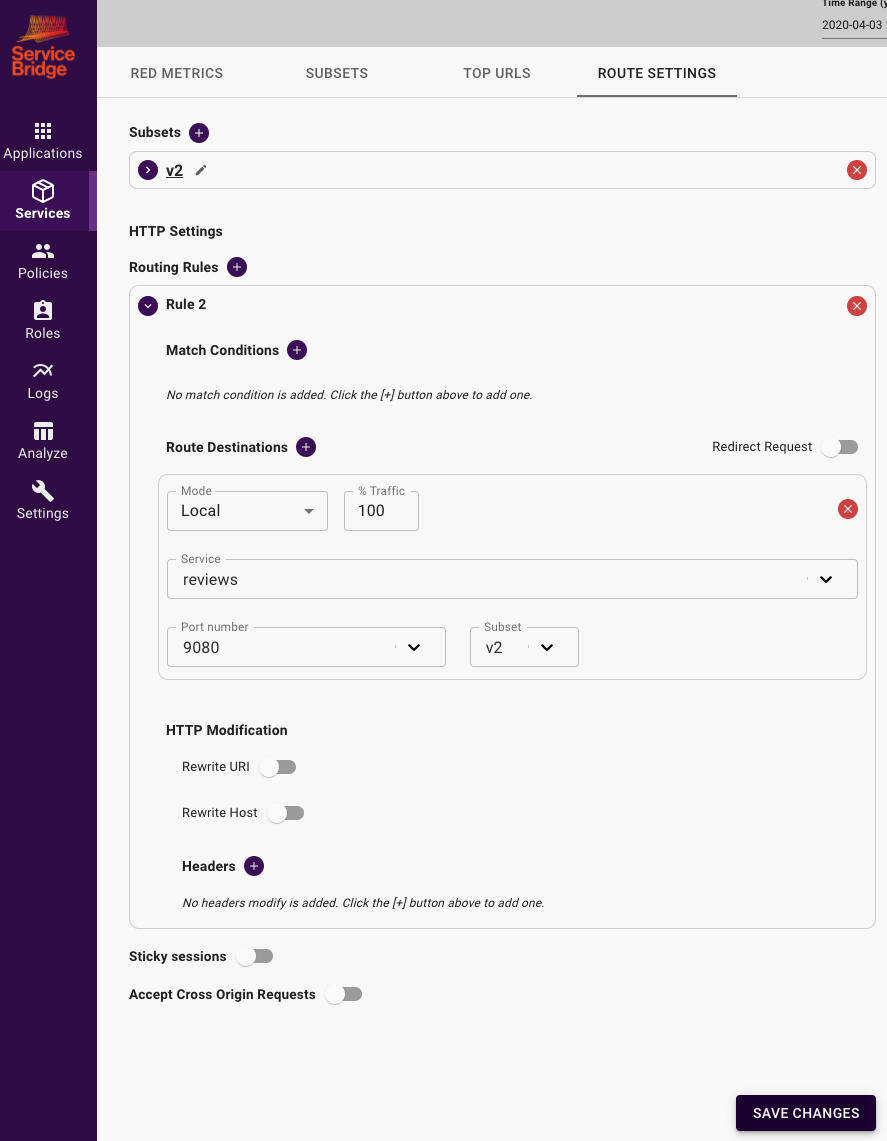Application Onboarding and canary release
This document describes a basic workflow for onboarding an application into TSB to perform a basic canary release of a service directing traffic progressively to a new version of it.
Initial application onboarding
An application in TSB maps to a set of services deployed across one or many Kubernetes namespaces. The first step then is to get your application deployed into a Kubernetes namespace which we won't be covering here as that is just following your regular deployment strategy in Kubernetes.
Istio injection
Application services need Istio sidecar to be present. You can label the
namespace with the istio-injection=enabled label to get sidecars injected
automatically.
Assuming you have the above in place, the next step is to create an application in TSB mapping to your application namespace.
Via API
The API call that will help here is the create application call.
curl --request POST \
-u admin \
--url https://${TCCIP}/v1/tenants/tenant/environments/dev/applications \
--header 'accept: application/json' \
--header 'content-type: application/json' \
--data -<<EOF
{
"id": "bookinfo",
"namespaces": [
"bookinfo-ns"
],
"forceMtlsBetweenServices": true
}
EOF
The above creates an application in TSB named bookinfo which is composed of
the services deployed in the bookinfo-ns namespace. Additionally, setting the
forceMtlsBetweenServices parameter to true causes mTLS to be enforced in
communications across all services in the namespace.
Via UI
Log into TSB UI, navigate to Applications in the navigation bar on the left
side. You will see the list of applications. Click in the + sign next to the
Applications title.
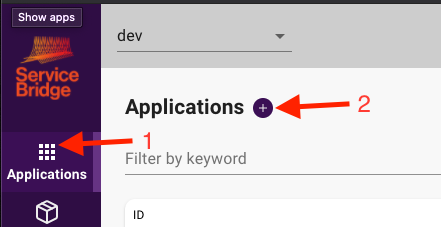
You will see the create application form where you will need to input the
application name as well as the list of namespaces conforming it. After you are
done, click the Create application button.
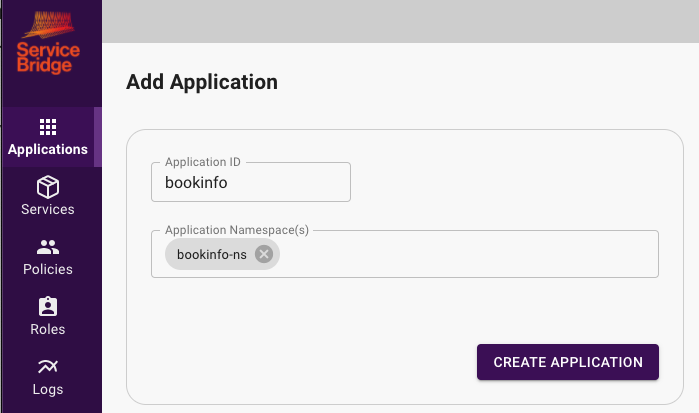
Should you want to enable mTLS in the namespace via the UI, you will need to
navigate Applications, enter your application by clicking in its name, then
navigate to the Reliability settings tab and toggle the Disallow non-mTLS connections between services switch to be activated.
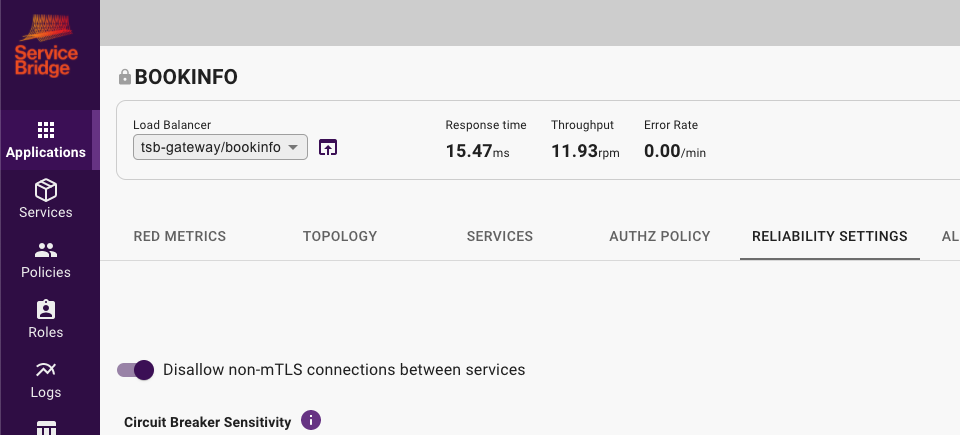
That is it. After creating the application, TSB will sync all services in the namespace automatically.
Canary release
The bookinfo application includes a service called reviews which has multiple
versions. When deploying this application without further customization, the
Kubernetes service will load balance between all instances (pods).
We will start updating the reviews service making all traffic to reach the
pods with label version=v1. We will also set a route that will direct traffic
to the pods with label version=v2 if the request has a given header.
Via API
First, we will need to retrieve the service:
curl --request GET \
--url https://${TCCIP}/v1/tenants/tenant/environments/dev/applications/bookinfo/services/reviews \
--header 'accept: application/json' > /tmp/reviews.json
Now we need to update the JSON object to reflect the route changes.
We are going to update the service JSON response and add a first level subsets
key in the JSON object so we can route traffic based on these subsets. Also, we
will need to update the routing rules in the service so traffic goes to v1
only except if the request includes a header named X-Release-Version with
value v2, then we will route the request to the v2 subset.
jq '.subsets = [
{
"labels": {
"version": "v1"
},
"name": "v1"
},
{
"labels": {
"version": "v2"
},
"name": "v2"
}
] | .internalRoutes.httpSettings.routeRules = [
{
"route": {
"destinations": [
{
"local": {
"application": "bookinfo",
"service": "reviews",
"subset": "v1"
},
"weight": 100,
"port": 9080
}
]
}
},
{
"match": [
{
"headers": {
"X-Release-Version": {
"exact": "v2"
}
}
}
],
"route": {
"destinations": [
{
"local": {
"application": "bookinfo",
"service": "reviews",
"subset": "v2"
},
"weight": 100,
"port": 9080
}
]
}
}
]' /tmp/reviews.json | tee /tmp/reviews-updated.json
Now we just need to update the service via API:
curl --request PUT \
-u admin \
--url https://${TSBIP}/v1/tenants/tenant/environments/dev/applications/bookinfo/services/reviews \
--header 'accept: application/json' \
--header 'content-type: application/json' \
--d @/tmp/reviews-updated.json
Via UI
Navigate to the bookinfo application, Services tab, click in the blue link
button next to the reviews service, then navigate to Route settings.
- Click in the
+sign next to theSubsetstitle to add a subset. By default, the UI will create subsets based on theversionlabel. Click again the+sign to create a secondv2subset. - Save the changes so the subsets are created.
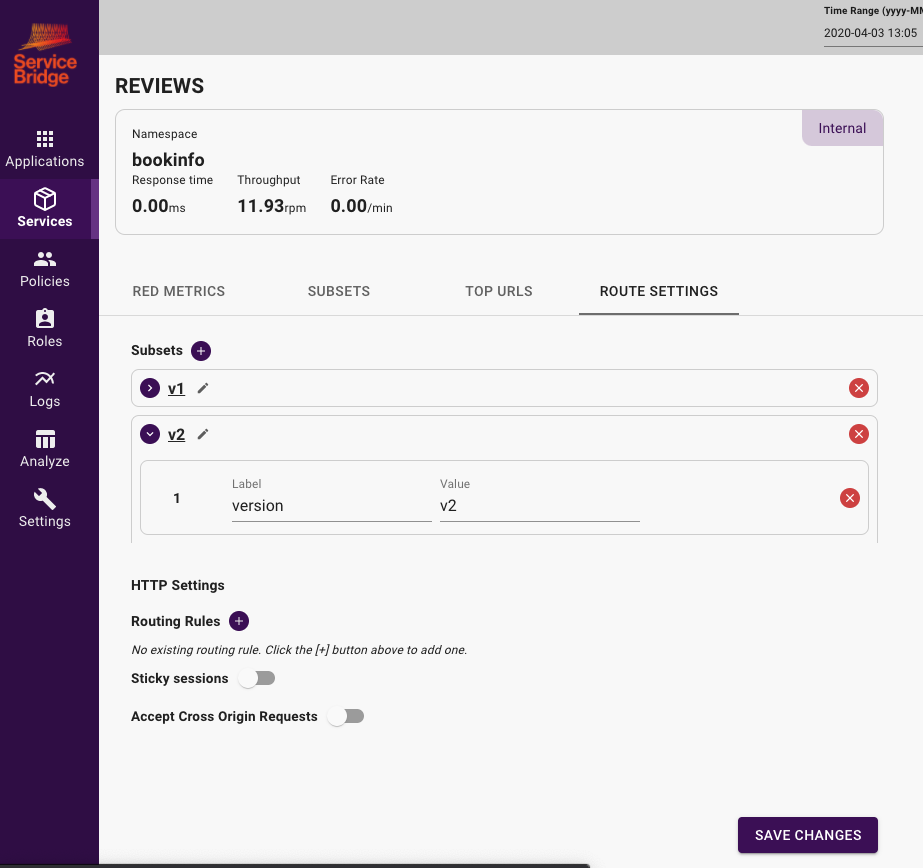
- Click the
+sign next to theRouting rulestitle. - For the first rule, create a new match condition by clicking the
+button next to theMatch Conditionstitle. Set attribute toHeader, header name toX-Release-Version, condition toexactand value tov2. In theRoute destinationsset thereviewsservice and select thev2subset.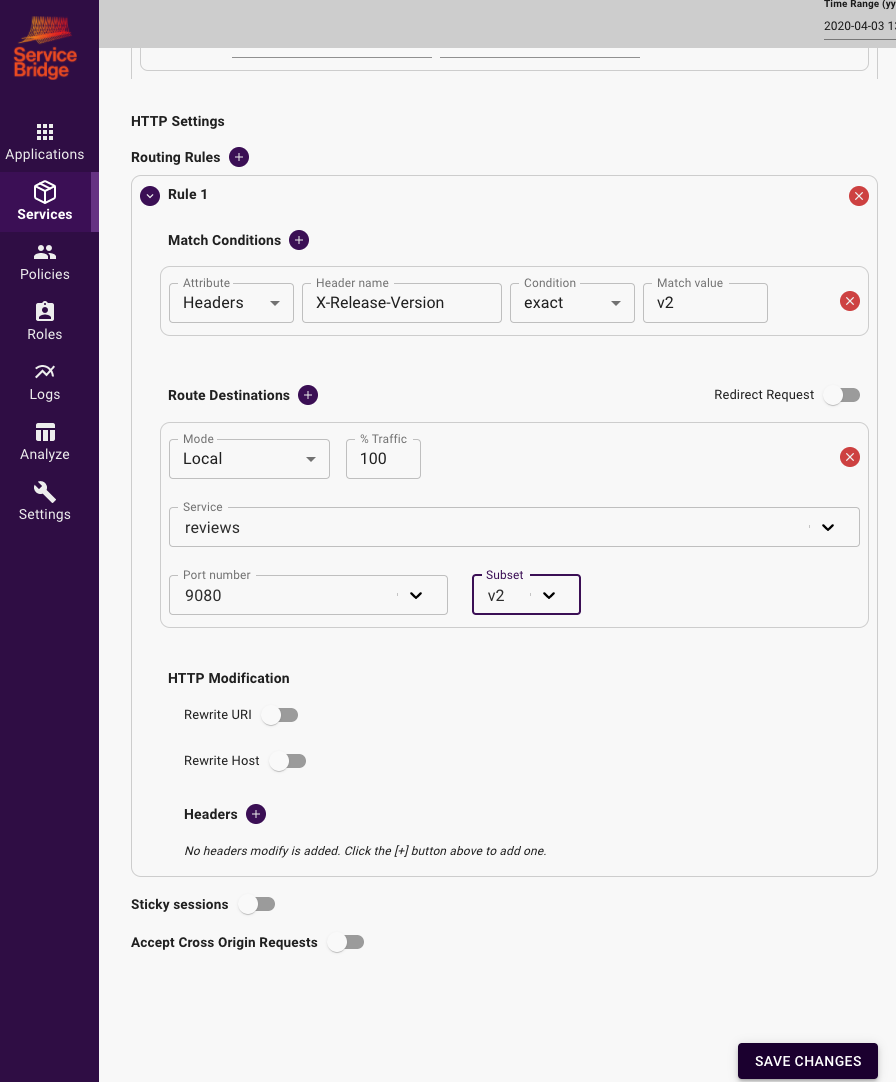
- Create a new routing rule, this time do not set any match condition, select
as route destination the
reviewsservice and thev1subset.
Traffic shifting to v2
Based on the previous state you'll need to, steering traffic to the v2 subset
is possible by once again updating the routing rules in the service. So we will
repeat what we did in the previous step, just adding a destination in the
default route (the one that does not specify a match condition) to the v2
subset and setting the percentage of traffic directed to each subset as desired.
Via API
First, we will need to retrieve the service as we did before:
curl --request GET \
--url https://${TCCIP}/v1/tenants/tenant/environments/dev/applications/bookinfo/services/reviews \
--header 'accept: application/json' > /tmp/reviews.json
Now we need to update the JSON object to reflect the route changes.
In this case the subsets already exist so we need to set the route
destinations as follows:
jq '.internalRoutes.httpSettings.routeRules = [
{
"route": {
"destinations": [
{
"local": {
"application": "bookinfo",
"service": "reviews",
"subset": "v1"
},
"weight": 80,
"port": 9080
},
{
"local": {
"application": "bookinfo",
"service": "reviews",
"subset": "v2"
},
"weight": 20,
"port": 9080
}
]
}
},
{
"match": [
{
"headers": {
"X-Release-Version": {
"exact": "v2"
}
}
}
],
"route": {
"destinations": [
{
"local": {
"application": "bookinfo",
"service": "reviews",
"subset": "v2"
},
"weight": 100,
"port": 9080
}
]
}
}
]' /tmp/reviews.json | tee /tmp/reviews-updated.json
We added a new destination in the default rule and changed the weight
attribute in each destination to direct 80% of traffic to the v1 subset and
20% to the v2 subset. Now we just need to update the service via API:
curl --request PUT \
-u admin \
--url https://${TSBIP}/v1/tenants/tenant/environments/dev/applications/bookinfo/services/reviews \
--header 'accept: application/json' \
--header 'content-type: application/json' \
--d @/tmp/reviews-updated.json
Via UI
Navigate to the bookinfo application, Services tab, click in the blue link
button next to the reviews service, then navigate to Route settings.
- Expand the routing rule that has no match condition (should be rule 2 if you followed the steps above).
- Change the
% Trafficof the existing destination rule to 80. Don't save yet. - Add a new destination rule, selecting the
reviewsservice and thev2subset. Set the% Trafficto 20. Save the changes.
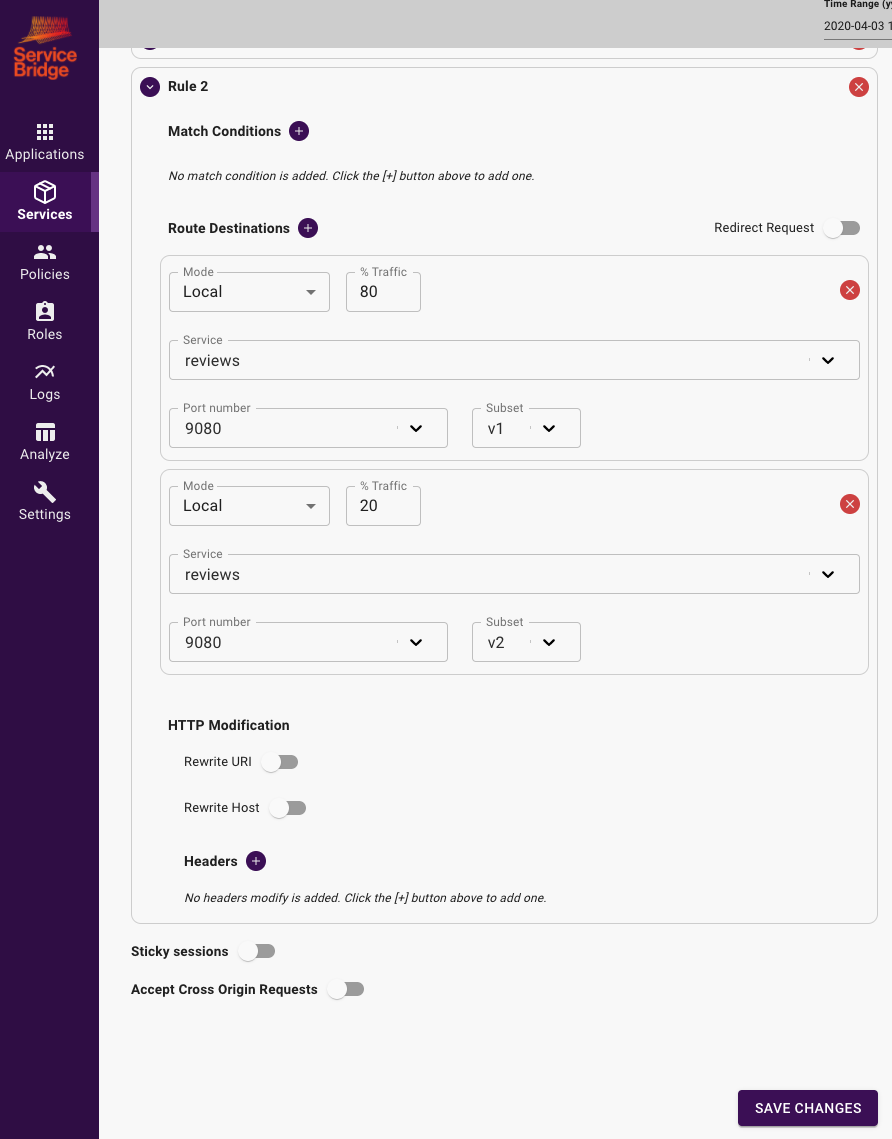
You can now repeat the steps above to progressively steer traffic to the new
v2 version in gradual steps by changing the weight in each destination (% of
traffic) until all traffic is directed to v2.
End-of-life for v1
At this point, with all traffic directed to the v2 subset you may want to
clean up the v1 subset and the routes that direct traffic to it.
Via API
Again, we will need to retrieve the service:
curl --request GET \
--url https://${TCCIP}/v1/tenants/tenant/environments/dev/applications/bookinfo/services/reviews \
--header 'accept: application/json' > /tmp/reviews.json
Now we need to update the JSON object to remove the v1 subset and the route
destination with weight 0 for it. We are also going to remove the route that
routed traffic to the v2 service based on request header as it will have the
same effect as the default route now.
jq '.subsets = [
{
"labels": {
"version": "v2"
},
"name": "v2"
}
] | .internalRoutes.httpSettings.routeRules = [
{
"route": {
"destinations": [
{
"local": {
"application": "bookinfo",
"service": "reviews",
"subset": "v2"
},
"weight": 100,
"port": 9080
}
]
}
}
]' /tmp/reviews.json | tee /tmp/reviews-updated.json
Now we just need to update the service via API:
curl --request PUT \
-u admin \
--url https://${TSBIP}/v1/tenants/tenant/environments/dev/applications/bookinfo/services/reviews \
--header 'accept: application/json' \
--header 'content-type: application/json' \
--d @/tmp/reviews-updated.json
Via UI
Navigate to the bookinfo application, Services tab, click in the blue link
button next to the reviews service, then navigate to Route settings.
- Click in the
+sign next to theSubsetstitle to add a subset. By default, the UI will create subsets based on theversionlabel. Click again the+sign to create a secondv2subset. - Click the red
xbutton for the subsetv1. Do not save yet. - Click the red
xbutton for the first destination rule, the one that routes based on the request header. Do not save yet. - In the remaining destination rule, delete the one that targets subset
v1which has a% Trafficof 0. - Save changes
